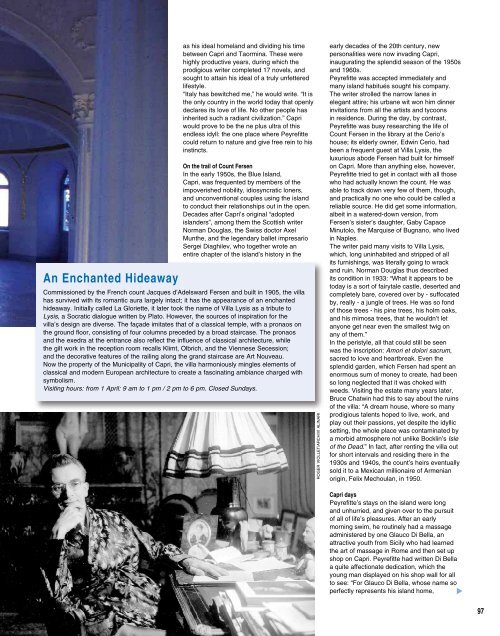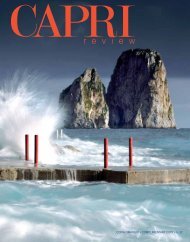COPIA OMAGGIO ⢠COMPLIMENTARY COPY EDIZIONI PRC
COPIA OMAGGIO ⢠COMPLIMENTARY COPY EDIZIONI PRC
COPIA OMAGGIO ⢠COMPLIMENTARY COPY EDIZIONI PRC
You also want an ePaper? Increase the reach of your titles
YUMPU automatically turns print PDFs into web optimized ePapers that Google loves.
An Enchanted Hideaway<br />
as his ideal homeland and dividing his time<br />
between Capri and Taormina. These were<br />
highly productive years, during which the<br />
prodigious writer completed 17 novels, and<br />
sought to attain his ideal of a truly unfettered<br />
lifestyle.<br />
“Italy has bewitched me,” he would write. “It is<br />
the only country in the world today that openly<br />
declares its love of life. No other people has<br />
inherited such a radiant civilization.” Capri<br />
would prove to be the ne plus ultra of this<br />
endless idyll: the one place where Peyrefitte<br />
could return to nature and give free rein to his<br />
instincts.<br />
On the trail of Count Fersen<br />
In the early 1950s, the Blue Island,<br />
Capri, was frequented by members of the<br />
impoverished nobility, idiosyncratic loners,<br />
and unconventional couples using the island<br />
to conduct their relationships out in the open.<br />
Decades after Capri’s original “adopted<br />
islanders”, among them the Scottish writer<br />
Norman Douglas, the Swiss doctor Axel<br />
Munthe, and the legendary ballet impresario<br />
Sergei Diaghilev, who together wrote an<br />
entire chapter of the island’s history in the<br />
Commissioned by the French count Jacques d’Adelsward Fersen and built in 1905, the villa<br />
has survived with its romantic aura largely intact; it has the appearance of an enchanted<br />
hideaway. Initially called La Gloriette, it later took the name of Villa Lysis as a tribute to<br />
Lysis, a Socratic dialogue written by Plato. However, the sources of inspiration for the<br />
villa’s design are diverse. The façade imitates that of a classical temple, with a pronaos on<br />
the ground floor, consisting of four columns preceded by a broad staircase. The pronaos<br />
and the exedra at the entrance also reflect the influence of classical architecture, while<br />
the gilt work in the reception room recalls Klimt, Olbrich, and the Viennese Secession;<br />
and the decorative features of the railing along the grand staircase are Art Nouveau.<br />
Now the property of the Municipality of Capri, the villa harmoniously mingles elements of<br />
classical and modern European architecture to create a fascinating ambiance charged with<br />
symbolism.<br />
Visiting hours: from 1 April: 9 am to 1 pm / 2 pm to 6 pm. Closed Sundays.<br />
ROGER VIOLLET/ARCHIVI ALINARI<br />
early decades of the 20th century, new<br />
personalities were now invading Capri,<br />
inaugurating the splendid season of the 1950s<br />
and 1960s.<br />
Peyrefitte was accepted immediately and<br />
many island habitués sought his company.<br />
The writer strolled the narrow lanes in<br />
elegant attire; his urbane wit won him dinner<br />
invitations from all the artists and tycoons<br />
in residence. During the day, by contrast,<br />
Peyrefitte was busy researching the life of<br />
Count Fersen in the library at the Cerio’s<br />
house; its elderly owner, Edwin Cerio, had<br />
been a frequent guest at Villa Lysis, the<br />
luxurious abode Fersen had built for himself<br />
on Capri. More than anything else, however,<br />
Peyrefitte tried to get in contact with all those<br />
who had actually known the count. He was<br />
able to track down very few of them, though,<br />
and practically no one who could be called a<br />
reliable source. He did get some information,<br />
albeit in a watered-down version, from<br />
Fersen’s sister’s daughter, Gaby Capace<br />
Minutolo, the Marquise of Bugnano, who lived<br />
in Naples.<br />
The writer paid many visits to Villa Lysis,<br />
which, long uninhabited and stripped of all<br />
its furnishings, was literally going to wrack<br />
and ruin. Norman Douglas thus described<br />
its condition in 1933: “What it appears to be<br />
today is a sort of fairytale castle, deserted and<br />
completely bare, covered over by - suffocated<br />
by, really - a jungle of trees. He was so fond<br />
of those trees - his pine trees, his holm oaks,<br />
and his mimosa trees, that he wouldn’t let<br />
anyone get near even the smallest twig on<br />
any of them.”<br />
In the peristyle, all that could still be seen<br />
was the inscription: Amori et dolori sacrum,<br />
sacred to love and heartbreak. Even the<br />
splendid garden, which Fersen had spent an<br />
enormous sum of money to create, had been<br />
so long neglected that it was choked with<br />
weeds. Visiting the estate many years later,<br />
Bruce Chatwin had this to say about the ruins<br />
of the villa: “A dream house, where so many<br />
prodigious talents hoped to live, work, and<br />
play out their passions, yet despite the idyllic<br />
setting, the whole place was contaminated by<br />
a morbid atmosphere not unlike Bocklin’s Isle<br />
of the Dead.” In fact, after renting the villa out<br />
for short intervals and residing there in the<br />
1930s and 1940s, the count’s heirs eventually<br />
sold it to a Mexican millionaire of Armenian<br />
origin, Felix Mechoulan, in 1950.<br />
Capri days<br />
Peyrefitte’s stays on the island were long<br />
and unhurried, and given over to the pursuit<br />
of all of life’s pleasures. After an early<br />
morning swim, he routinely had a massage<br />
administered by one Glauco Di Bella, an<br />
attractive youth from Sicily who had learned<br />
the art of massage in Rome and then set up<br />
shop on Capri. Peyrefitte had written Di Bella<br />
a quite affectionate dedication, which the<br />
young man displayed on his shop wall for all<br />
to see: “For Glauco Di Bella, whose name so<br />
perfectly represents his island home,<br />
<br />
97



